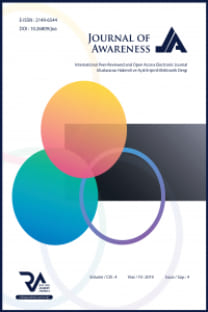PLAZMA ATEROJENİK İNDEKSİN DİYABETES MELLİTUS TİPLERİ ARASINDA KARŞILAŞTIRILMASI
Amaç: Diyabetes mellitus (DM), birçok sistem ve organı etkileyen kronik metabolik bir hastalıktır. Diyabetik dislipidemi, DM’nin majör makrovasküler komplikasyonlarından biri olarak sayılmaktadır. Plazma aterojenik indeksi (PAİ), kardiyovasküler hastalık (KVH) için bağımsız belirleyici bir etken olarak kabul edilir. Bu çalışmanın amacı tip-1 DM ile tip-2 DM hasta grupları arasında PAİ değerlerini karşılaştırmaktır. Materyal ve Metod: Çalışma verileri son bir yıl içinde kardiyoloji polikliniğine başvuran ve çalışma kriterlerine uyan 58 hastanın retrospektif olarak dosyalarının taranması ile elde edildi. Hastalar tip-1 DM grubunda 20 hasta ve tip-2 DM grubunda 38 hasta olmak üzere iki gruba ayrıldı. PAİ, plazma trigliserid’ in plazma yüksek dansiteli lipoprotein’e bölümünün logaritması alınarak elde edildi. Bulgular: Tip-1 DM grubunda PAI 0,29±0,31, tip-2 DM grubunda PAI 0,62±0,35 olarak ölçüldü (p=0.001) Sonuç: KVH’in önemli bir öngördürücüsü olan PAİ tip-2 DM olan hastalarda tip-1 DM olan hastalara göre daha yüksek saptanmıştır.
Anahtar Kelimeler:
Plazma aterojenik indeks, diyabetes mellitus, ateroskleroz
COMPARISON OF PLASMA ATEROGENIC INDEX BETWEEN DIABETES MELLITUS TYPES
Objective: Diabetes mellitus (DM) is a chronic metabolic disease that affects several systems and organs. Diabetic dyslipemia is considered to be one of the major macrovascular complications of DM. Plasma atherogenic index (PAI) is considered as an independent determining factor for cardiovascular disease (CVD). The aim of this study was to compare the PAI values between Type-1 DM and type-2 DM patient groups.
Keywords:
Plasma atherogenic index, diabetes mellitus, atherosclerosis,
___
- Bluestone JA., 2010, Pathogenesis and clinical interventions in type 1 diabetes. Nature, 464, 1293-1300.
- Bulut T., 2017, The prevalence of dyslipidemia and associated factors in children and adolescents with type 1 diabetes. J Pediatr Endocrinol Metab, 30(2), 181–187.
- Dobiasova M., 2006, Atherogenic index of plasma as a significant predictor of cardiovascular risk: from research to practice, Vnitr Lek, 52, 64-71.
- Dobiasova M., 2011, Cholesterol esterification and atherogenic index of plasma correlate with
- Ettinger WH., 1992, Lipoprotein lipids in older people: results from the Cardiovascular Health Study, Circulation, 86, 858-869.
- Guariguata L., 2014, Global estimates of diabetes prevalence for 2013 and projections for 2035, Diabetes Res Clin Pract, 103:137–149.
- Isomaa B., 2001, Cardiovascular morbidity and mortality associated with the metabolic syndrome. Diabetes Care, 24, 683–689.
- Kahn SE., 2013, Pathophysiology and treatment of type 2 diabetes: perspectives on the past, present and future. Lancet, 383, 1068-1083.
- lipoprotein size and findings on coronary angiography, J Lipid Res, 52, 566-571.
- Schaefer EJ., 1994, Effects of age, gender, and menopausal status on plasma low density lipoprotein cholesterol and apolipoprotein B levels in the Framingham Offspring Study, J Lipid Res, 35(5), 779-792.
- Taskinen MR., 2003, Diabetic dyslipidaemia: from basic research to clinical practice, Diabetologia 46, 733–774.
- Turner RC., 1988, Risk factors for coronary artery disease in non-insulin dependent diabetes mellitus: United Kingdom Prospective Diabetes Study (UKPDS 23), BMJ 316, 823–828.
- Verges B., 2015, Pathophysiology of diabetic dyslipidaemia: where are we? Diabetologia, 58, 886–899.
- Zimmet PZ., 2014, Diabetes: a 21st century challenge. Lancet Diabetes Endocrinol 2, 56–64.
- ISSN: 2149-6544
- Başlangıç: 2016
- Yayıncı: Rating Academy
Sayıdaki Diğer Makaleler
PLAZMA ATEROJENİK İNDEKSİN DİYABETES MELLİTUS TİPLERİ ARASINDA KARŞILAŞTIRILMASI
Ercan AKŞİT, Özge TURGAY YILDIRIM, Ayşe HÜSEYİNOĞLU AYDIN, Fatih AYDIN
ÇEVRE SORUNLARINA EĞİTİMLE FARKINDALIK OLUŞTURMA
GEOMETRİNİN SANAT ESERİ ÜRETİMİNDE YARATICILIĞA ETKİSİNE BİR ÖRNEK, "EVİRE ÇEVİRE" HEYKEL SERGİSİ*
Münevver Berrin KAYMAN KARAGÜL
Aysen ŞİMŞEK KANDEMİR, Öznur GÖKKAYA
Sevinç ÖLÇER, Dilek AŞIKOĞLU ÖZDEMİR
UÇAK BİLETLERİNDE BELİRLİLİK İLKESİNİN İRDELENMESİ
TÜRKİYE'DE SAĞLIK TURİZMİNİN POTANSİYELİ VE GELECEĞİ: SWOT ANALİZİ
